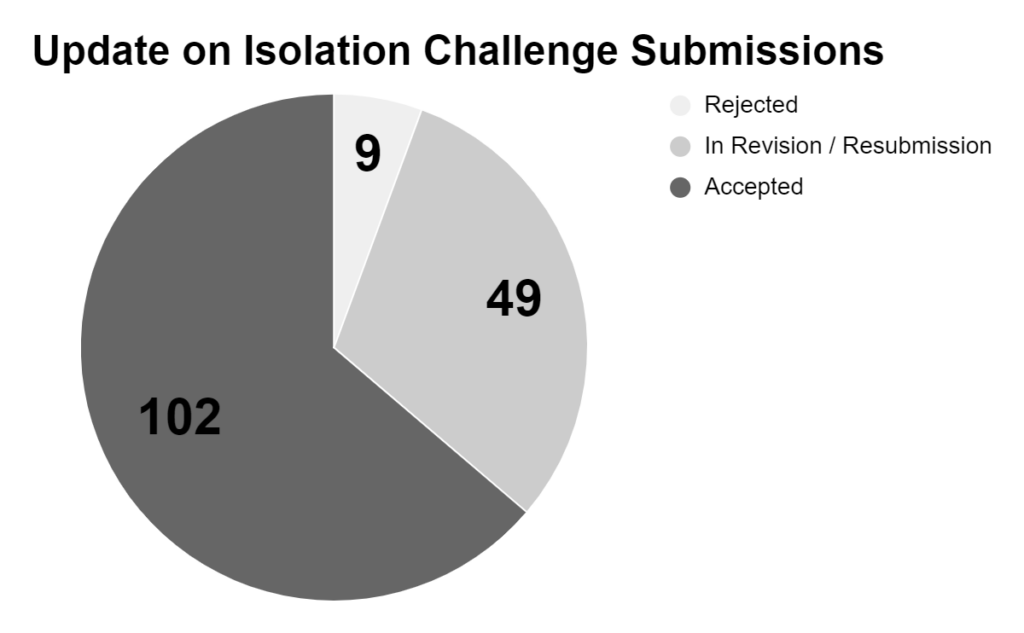“Every object persists in its state of rest or uniform motion in a straight line unless it is compelled to change that state by forces impressed on it.”
Sir Isaac Newton, Principia Mathematica Philosophiae Naturalis (1686)
The experience of our department during the initial pandemic response shared many of the features familiar to our colleagues across the western world — clinical shutdown, sheltering-in-place and an ominous foreboding, as we watched the crisis take shape.1 Unique to our experience, while protocols were refined and implemented to allow for an eventual reopening, we took up a formal charge to keep our collective hands from falling idle: the Mayo Neurosurgery Isolation Challenge. An unprecedented exercise in friendly competition centered on research output in the month of April, the Isolation Challenge was a 30-day open season on submission, staked on prizes and other incentives, which ultimately resulted in the generation of at least 160 peer-reviewed journal articles and grant proposals. Perhaps most importantly, the Isolation Challenge sparked a fresh enthusiasm for collaboration, camaraderie and academic zeal, which markedly raised our collective mood and motivation in a time otherwise centered on distress.
As April transitioned to May and our clinical practice resumed — first slowly, and then with the force of so many urgent operations that had been delayed — we wondered whether we might see a parallel decline in academic output, as though the Isolation Challenge is a tsunami, followed by an ebb tide. And yet, even as the eagerness to return to patient care took hold, we recognized that our community had in fact been supercharged by our experiences in April.
Rather than taking these sentiments at face value, however, we endeavored to quantify the inertial force that the Isolation Challenge had generated within us. In July, a brief, two-part survey circulated throughout the department: first, of the papers and grants submitted during the April event, how many were accepted, rejected or in revision; and second, in the ensuing months of May, June and July, how many new submissions were generated. The response rate was complete; the data, genuinely elevating.
The initial swell was both swift and expansive. Among 160 unique manuscripts or grants, 102 were accepted, 49 under review and nine had been rejected without interim resubmission, principally due to grant cycle considerations (Figure 1). Even more noteworthy, in May, June and July, the unique, monthly submissions totaled 93, 70 and 91 — nearly a three-fold increase in our annual average monthly output from 2019, which we had maintained throughout this clinically and psychologically chaotic quarter (Figure 2).
Like the epidemiologic waves of COVID-19 itself, the true nature of these events we are observing within our academic environment are challenging to model and predict. They may be due to fluctuations from a generous competitive spirit or an anomalous academic quarter — a statistical outlier, that will ultimately regress to the mean. They may be local expressions of broader trends — reflected, for example, by the 55% increase in new submissions to Journal of Neurosurgery during the first four months of 2020, as compared to 2019.2 Or perhaps, as we would suggest, it is something altogether more profound: a genuine sea change for Mayo Clinic Neurosurgery. Fueled by the reckonings and reflections that COVID-19 has instigated and catalyzed by the Isolation Challenge, we are propelled forward with new momentum and an extraordinary drive to not simply survive, but to thrive.
Figures
Figure 1: Current status of 160 unique submissions generated by Mayo Clinic Neurosurgery during the April 2020 Isolation Challenge
Figure 2: Comparison between monthly grant or peer-reviewed journal submissions from Mayo Clinic Neurosurgery, May through July 2020, as compared to 2019 monthly average (29 submissions per month)
References
[expand title=”View All”]
1. Graffeo CS, Parney IA, Wessel B, Spinner RJ: A Surprise Sabbatical: How Mayo Clinic Neurosurgery Coped with COVID-19. World Neurosurg:2020 Available: https://dx.doi.org/10.1016/j.wneu.2020.07.172.
2. Kondziolka D, Couldwell WT, Rutka JT: Editorial. Putting pen to paper during a pandemic: increased manuscript submissions to the JNS Publishing Group. J Neurosurg:1–3, 2020
[/expand]










